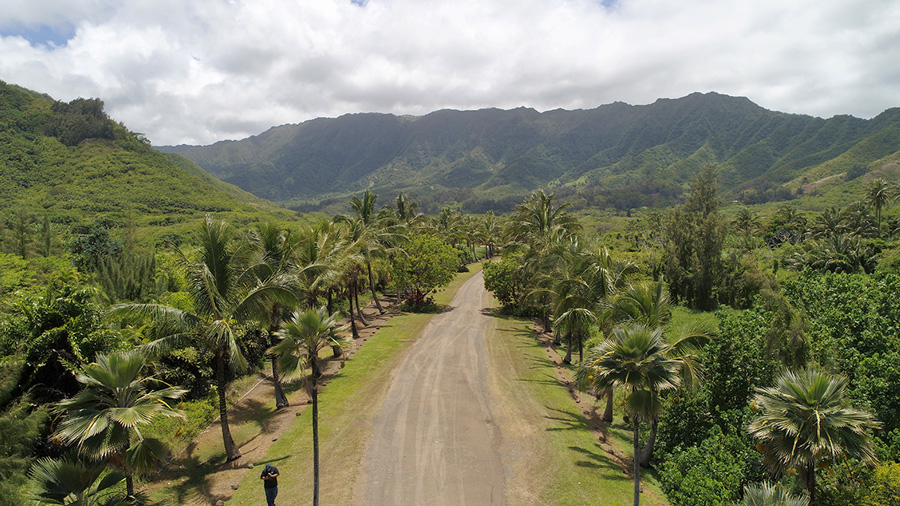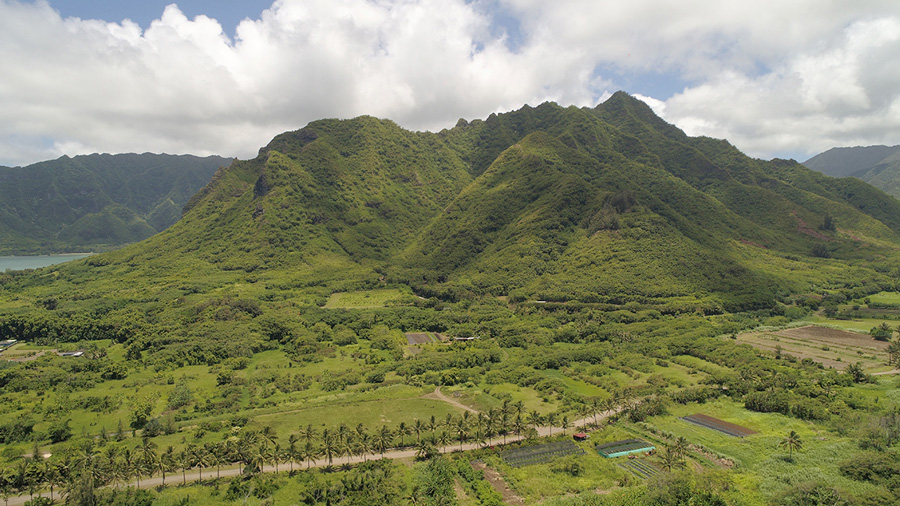Punalu‘u, O‘ahu
He ‘āina momona ‘o Punalu‘u - Punalu‘u is a place of abundance
Our relationship to the ‘āina and our Hawaiian values sustain the traditions and productivity of the ahupua‘a, stimulate learning opportunities, nurture a healthy community, and perpetuate its rural character.
Meaning of Punalu‘u
Punalu‘u translates as “diving spring,” implying a spring of fresh water. The ahupua‘a is well known for its abundance of water. The name “Punalu‘u” is also said to derive from the coral lime, known as puna, used for hair bleach. This correlates with the literal translation “coral dived for.” Another interpretation of “Punalu‘u” is found in the Hawaiian language newspaper, Loea Kalai ‘Āina, which is a “spring in the sea of cool fresh water, cool as the water from the clouds when drunk.”
Location
The ahupua‘a of Punalu‘u is located in the district of Ko‘olau Loa between Kahana Valley and Hau‘ula on O‘ahu. Kamehameha Highway runs along the makai portion of Punalu‘u and is the only road that connects the area with the rest of the island. Punalu‘u, like the rest of Ko‘olau Loa, is predominantly rural. Small clusters of rural housing and a few country stores dot the agricultural landscape along either side of Kamehameha Highway. Punalu‘u Stream is recognized in the “Hawai‘i Stream Assessment” as one of the most biologically diverse and healthy streams on O‘ahu.
Environment
The area has a wet climate, receiving 60-80 inches of rain per year. As a testament to this wet climate, one of the Punalu‘u rains is referred to as Ka ua kīkē hala, or “the hala-pelting rain.” Located on the windward side of O‘ahu, Punalu‘u receives gentle offshore trade winds from the northeast. From the famous legend of the Wind Gourd of La‘amaomao, moa‘e is a name of the wind within Punalu‘u, meaning “trade winds.”
Encompassing Lands
While Punalu‘u is an independent ahupua‘a, the name “Punalu‘u” is often used to reference a larger area that includes the ahupua‘a of Punalu‘u as well as six smaller neighboring ahupua‘a to the north: Wai‘ono, Pūhe‘emiki, Kapano, Hale‘aha, Papa‘akoko, and Kaluanui. Kamehameha Schools’ lands total about 3,600 acres or approximately 60 percent of the larger area that is called Punalu‘u.
Natural Resources
The Ko‘olau Loa District is traditionally noted in oral histories and written records as a place with an abundance of resources both in mauka and makai areas of each ahupua‘a. The region is endowed with a plentiful water supply flowing from several major streams which include Kaluanui Stream, Punalu‘u Stream, Kahana Stream, Ka‘a‘awa Stream and Makaua Stream. Native plants in the upland forests included koa, olonā, hau, ‘ōhi‘a lehua, and ‘ōhi‘a ‘ai.
Pre-Historical Land Use
In the 15th Century, Kalamakua, the ruling chief of O‘ahu is credited with establishing numerous ‘auwai (irrigation ditches) and agricultural terraces throughout the island. These features were predominantly used for the cultivation of kalo (taro). In Ko‘olau Loa, the development of these irrigation systems sustained a sizeable population for many generations. In Punalu‘u, the earliest accounts of the area note that an extensive lo‘i kalo and ‘auwai system existed and that significant amounts of kalo were cultivated in the area. Kahana and Punalu‘u were known as the bread baskets of Ko‘olau Loa.
Māhele ‘Āina
After the Great Māhele of 1848, the original land title of the Punalu‘u Ahupua‘a was awarded to the great-grandson of Kamanawa, William Pitt Leleiōhōkū, including 4,215 acres. Kamanawa was a trusted elder and advisor to Kamehameha the Great. Only 30 of 48 claims for kuleana in Punalu‘u were awarded for a total of 89.25 acres. Eight claimants died prior to the finalization of the awards, while 15 claims were disallowed. The original titles for kuleana in Punalu‘u Valley note usage for kalo, crops and house lots.
After his death, Leleiōhōkū’s lands were passed on to his son William Pitt Kīna‘u. However, this son died young, and the lands were passed to his mother Luta “Ruth” Ke‘elikōlani. Ke‘elikōlani was a granddaughter of Kamehameha I. Upon Ke‘elikōlani’s death in 1883, she passed her lands on to her cousin, Bernice Pauahi Bishop and her husband Charles Reed Bishop. Almost a year later, in 1884, Bernice Pauahi Bishop passed away. Her combined landholdings, including those in Punalu‘u, were dedicated to the establishment of the Bishop Estate Trust and the Kamehameha Schools.
Historical Land Use
During the latter half of the 19th century, rice became the predominant cash crop grown in Punalu‘u. During the peak of rice production, “the ripening rice would turn the entire plain between the shoreline and the mountainside into a sea of gold undulating in the wind.” Initially, Chinese immigrants worked the rice paddies as laborers, and, over time, some went on to become businessmen and landowners in the area. The Chinese community in the area was estimated to have been between 300 and 400 people at one time. These Chinese immigrants and their descendants helped shape the land and water development in Punalu‘u and surrounding areas. Today, many of the old Hawaiian families in Punalu‘u and the surrounding areas are also descendants of the Chinese immigrants who settled in the region during the early days of rice cultivation.
The mouth of Wai‘ono Stream served as an ideal harbor for coastal schooners and inter-island steamers because of its naturally carved deep channel. A pier was built out into Mamalu Bay and became a key trading point, bringing in outside supplies while rice and other commercial crops were exported. The mouth of Wai‘ono stream was also a good fishing ground for ‘o‘opu.
Around 1910, rice cultivation declined in Punalu‘u and the surrounding areas as older laborers could no longer tend to rice paddies, and the local demand for rice declined. During this time, kuleana owners in Punalu‘u entered into lease-hold and sales agreements with the Chinese. As rice production declined, the Chinese, and a growing population of Japanese farmers, began to revive and cultivate lo‘i in Punalu‘u.
In 1906, seven Chinese immigrants involved in rice farming founded the Punalu‘u Yin Sit Sha or “debate society” to discuss the political disorder occurring in China at the time. As the organization evolved over time, the Punalu‘u Yin Sit Sha shifted its focus from mainland China issues to local issues. The organization served as a school and local civic center. Today, there is still a strong Chinese presence in Punalu‘u. The Punalu‘u Yin Sit Sha has property holdings in the area and holds several cultural events every year, including memorial services, picnics and anniversaries.
Also, in 1906, Bishop Estate entered into a new lease agreement for its lands in Punalu‘u with James B. Castle after the Estate’s prior lease agreement with a Chinese Hui expired. Castle created the Ko‘olau Agricultural Company. In the first years of Castle’s management of the lands, hundreds of acres of land were leased to Japanese tenants for the cultivation of taro and pineapples. Castle also constructed the Punalu‘u Ditch system around this time. The ditch network consisted of a diversion dam, flume, 12 tunnels and a series of smaller ditches that spread across Punalu‘u, Makaua, and extended four miles to Hau‘ula. Water was diverted from Punalu‘u Stream at about the 210-foot elevation.
The Punalu‘u Ditch system was originally constructed to irrigate sugarcane lands in Punalu‘u. In 1905, the Ko‘olau Railway Company obtained an easement for its line through Punalu‘u. The rail line extended 11 miles along the Ko‘olau Loa kula lands from Kahana to Kahuku and was completed in 1908. Concrete-lined irrigation channels were added to the ditch system in 1922 to transport water. Sugar was cultivated in Punalu‘u until the 1970s.
Punalu‘u Stream Restoration Project
The Punalu‘u ahupua‘a has been impacted by a range of historical impacts, including water diversions; invasion by non‐native aquatic, plant, and animal life; stream channelization; unprotected stream crossings; land grading and alteration of natural drainage patterns; tillage; livestock grazing; aquaculture; and residential development.
Currently, over 50 acres of the lower Punalu‘u Valley have flooded annually. Flooding causes economic hardship and appears to be getting worse, possibly due to sedimentation within the stream. The flooding on July 19, 2014, damaged roads, properties, fields, and crops.
KS identified the lower Punalu‘u Stream Valley as an opportunity to implement a project that incorporates its ahupua‘a management strategy to provide flood mitigation and restore natural ecological form and process.
The primary objective of the Punalu‘u Stream Restoration Project is to develop sustainable flood protection and restore hydrologic processes in the Punalu‘u watershed altered by a previous lessee, with a focus on the lower reach of Punalu‘u Stream and its floodway. Visit the Punalu‘u Stream Restoration Project page and learn more.















